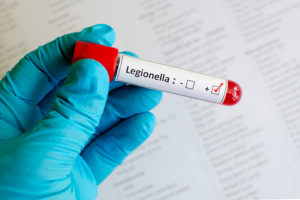
We’re nationally recognized attorneys representing people who were sickened or killed in Legionnaires’ disease outbreaks. We’ve collected millions of dollars for our clients in cases throughout the United States against hotels, casinos, resorts, hospitals, office buildings, housing developments and health care facilities that caused Legionnaires’ outbreaks. You can contact our Legionnaires’ attorneys today at 1-888-377-8900 or online here.
If you’re an outbreak victim, you should know how we prove your case. Here are five of the most important steps:
Step 1 – Confirmation off physical symptoms:
This involves confirming that you have or recently had fever, myalgia (muscle pain) or x-ray evidence of pneumonia.
Step 2 – Confirmation of presence of Legionella bacteria:
 One or more laboratory tests is used to detect evidence of Legionella bacteria in your body.
One or more laboratory tests is used to detect evidence of Legionella bacteria in your body.
There are several different kinds of laboratory tests that may be used. At least one of them has to be positive for the bacteria that causes Legionnaires’ disease.
One of the tests involves isolation of the Legionella organism from respiratory secretions, lung tissue, pleural fluid, or otherwise normally sterile fluid from the body. In this test, the fluid and/or tissue is usually obtained by use of a bronchoscope – insertion of a narrow tube through the nose or mouth, down through the windpipe (trachea) and into the respiratory system in order to retrieve secretions or tissue. If the samples are positive for Legionella organisms, the diagnosis of Legionnaires’ disease is confirmed.
Because this test method is complicated, uncomfortable and takes several days before results are confirmed, a more common test involves using the patient’s urine to detect antigens of Legionella bacteria (antigens are molecules capable of stimulating an immune response). This test is not as reliable as the first test, but it’s faster and less expensive to run and a “positive” results in official confirmation of Legionnaires’ disease.
It’s also important to realize that the urinary antigen test can detect Legionella infections in some cases for days to weeks after treatment. This means that if you weren’t tested when you were acutely ill, it still may be possible to confirm the disease even after you are feeling better.
Another laboratory test to confirm Legionnaires’ disease involves use of antibody titers. Unlike antigens, antibodies are proteins found in the blood formed in response to exposure to antigens. Antibodies bind to antigens which helps to eliminate antigens from the body. Thus, the presence of Legionella antibodies is suggestive of current or past Legionnaires’ infections. When measured over time, a substantial increase in the number of antibodies indicates a recent infection.
There are other laboratory methods including detection of Legionella species by a validated nucleic acid assay.
Step 3 – Confirmation that you could have been exposed by an identified source of aerosolized Legionella bacteria:
This involves confirmation that you were exposed to aerosolized Legionella organisms from the same source and during the same time period as other people from the same outbreak. For example, if the source of the outbreak is a hot tub at a hotel, we have to confirm you were actually in or near the hot tub. We also have to confirm that the timing of the onset of your symptoms was consistent with that exposure.
We know, for example, that the time period between exposure and symptom onset is usually 2 to 10 days (but up to 16 days has been recorded in some outbreaks). That time period helps pinpoint where you were when you were exposed to the Legionella organisms. For example, if you were at a hotel with a hot tub two to ten days before you became symptomatic, that’s additional evidence that the hot tub was the source of your infection.
Step 4 – Confirmation that the identified source was part of a Legionnaires’ disease outbreak:
We will confirm that other persons were sickened by the same source and at the same time you were. That’s important because many health departments will not investigate a solitary case of Legionnaires’ disease. That’s because Legionella bacteria are relatively ubiquitous (present in many places simultaneously) pathogens which means that it’s usually difficult to rule out others sources of exposure if there is just one case. Thus, it takes evidence of two or more Legionnaires’ cases who were sickened during the same general time period and who were exposed to the same source before an outbreak can be established.
Step 5 – Confirmation that the outbreak was investigated and you were identified as part of it:
This is the final piece of the puzzle: confirmation that a county or state health department investigated the outbreak, identified its likely source, and listed you as an outbreak case.
In every state, a laboratory-confirmed positive test for Legionella bacteria must be reported by a doctor or hospital to a state or county health department. That report, especially if there are several of them, is supposed to trigger an investigation which, if successful, will identify the source of the outbreak, the reasons it occurred, and identify the persons sickened as a result of it.
If you were sickened or a loved one was killed as a result of Legionnaires’ disease, you owe it to yourself and your family to consult with the Legionnaires’ disease experts at Pritzker Hageman. Call, email or text us today for a free consultation.
Contact Attorney Fred Pritzker and His Legionnaires’ Team
Phone: 1-888-377-8900 | Text: 612-261-0856
Yes, I’d Like a Free Consultation with a Legionnaires Lawyer
To summarize, these are the factors we look at in evaluating your Legionnaires’ disease case:
- Did you have symptoms and x-ray results consistent with Legionnaires’ disease?
- Was there laboratory confirmation that Legionella bacteria were present in your body?
- Were you exposed to the same source during the same general time period as other outbreak case patients?
- Were there two or more case patients from this outbreak?
- Did a state or local health department investigate the outbreak, confirm its source and identify you as an outbreak case patient?